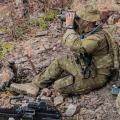My name is Pietro Ruggeri; a Joint Fires Team (JFT) Commander at 8th/12th Regiment, Royal Australian Artillery (RAA). My EX TALISMAN SABRE 17 experience comes from the less publicised 'Northern Exercise' which occurred at Mount Bundy Training Area (MBTA) in late June. Throughout the exercise I was attached to D Company (D Coy), 5 RAR as a part of Battle Group (BG) Tiger. I intend to discuss the lessons I learnt from conducting an Air Mobile Operation (AMO) in a coalition environment in which offensive support was provided by United States (US) forces.
Offensive Support to Air Mobile Operations
D Coy’s first task was to seize MBTA’s airfield via AMOs with lift provided by Marine Rotational Force – Darwin’s air combat element. This required detailed planning with operations officers and pilots from the Airspace Control Element (ACE) and 4th Marine Regiment headquarters (who were also headquarters for the Special Marine Air Ground Task Force [SP-MAGTF]). As the OC’s JFT commander, I went along to any planning conferences, back briefs and orders with him in order to fully understand the situation and thus integrate into the manoeuvre plan. Although I wasn’t required for higher level or detailed planning, this provided me with the best possible advice I can give to any future commanders conducting AMO with a coalition partner: meet the pilots!
While operations officers, ground commanders and air commanders gathered around maps and discussed intricate timelines, I made my way around the room introducing myself to the marines I would be speaking to once on the ground and isolated from my Battery Commander (the BG’s senior fires officer). In doing so I met the Super Cobra pilot who would also be the escort flight leader and the artillery officer in charge of the 120mm mortar platoon attached to the SP-MAGTF. I was able to exchange mobile numbers, talk shop and develop working relationships prior to the stress of being on the ground and dealing with the inherent friction of AMO. This was also my opportunity to conduct lower level planning and develop simple control measures to ease our integration.
I also sought to mitigate this friction by discussing communications with the Osprey and Cobra pilots. I ensured I knew exactly how to establish comms from inside the transport aircraft, how best to communicate with the escort aircraft whilst airborne and on the ground, and what the contingency plan was for poor comms. I asked much the same questions of the gunners, indicating where I intended to sight their base plate location and how we would marry up with or without comms. Once on the ground at MBTA airfield I married up with a 2 Commando Joint Terminal Attack Controller who had already established a local air picture and coordinated the escort aircraft’s strikes onto identified targets. He then integrated with my Joint Fires Observer to maintain aerial fire support for D Coy and BG Tiger. As darkness fell, and after I had reconnoitred a likely base plate location, the mortars landed via Hercules C130. I tried for 20 minutes to raise them, callsign ‘Blacksheep’, on the agreed net. Without comms we planned on a physical marry up in the south-east corner of the airfield. What occurred thereafter was an excellent example of why we need close working relationships with coalition partners:
Upon hearing the sound of metal on metal, likely a towed mortar unhooking, I called out, 'Blacksheep, where’s your LT?'
From the dark and without visual was the return, 'Yo Ruggers, is that you? Where are we going bro?'
These pre-established relationships and control measures were able to be carried on to a subsequent AMO two days later. This time I didn’t get the opportunity to conduct face-to-face planning with any of the other stakeholders, however, after having met them earlier and established relationships via callsigns we were able to overcome stark friction with minimal confusion.









